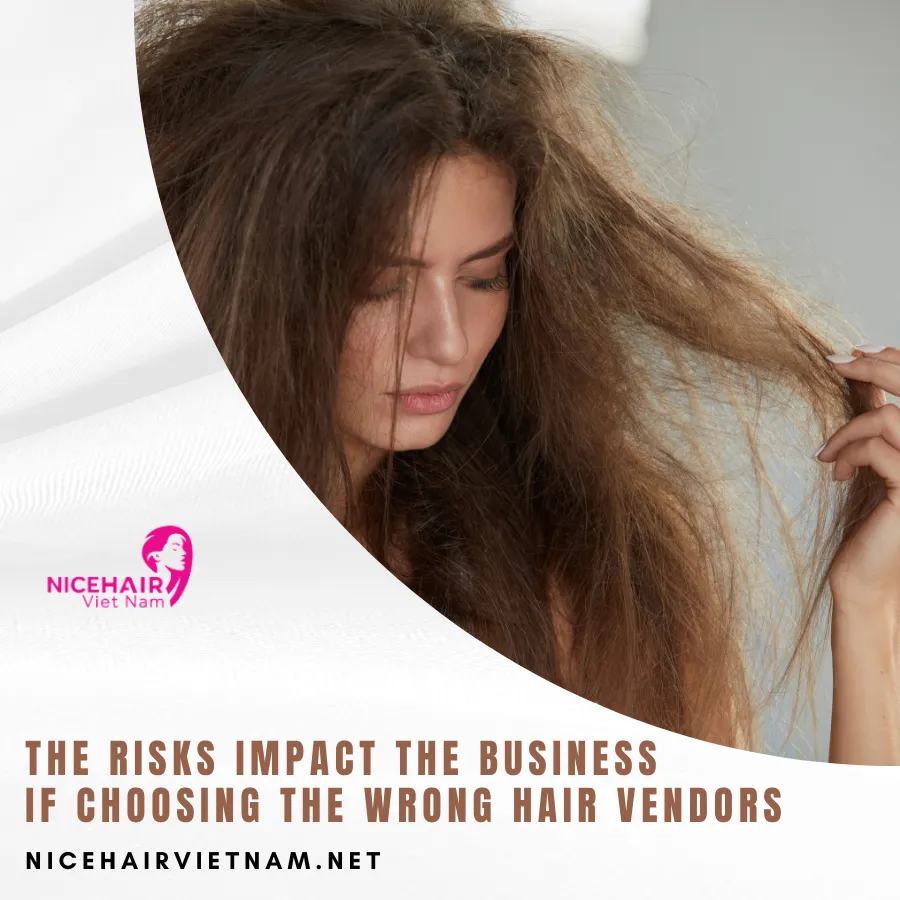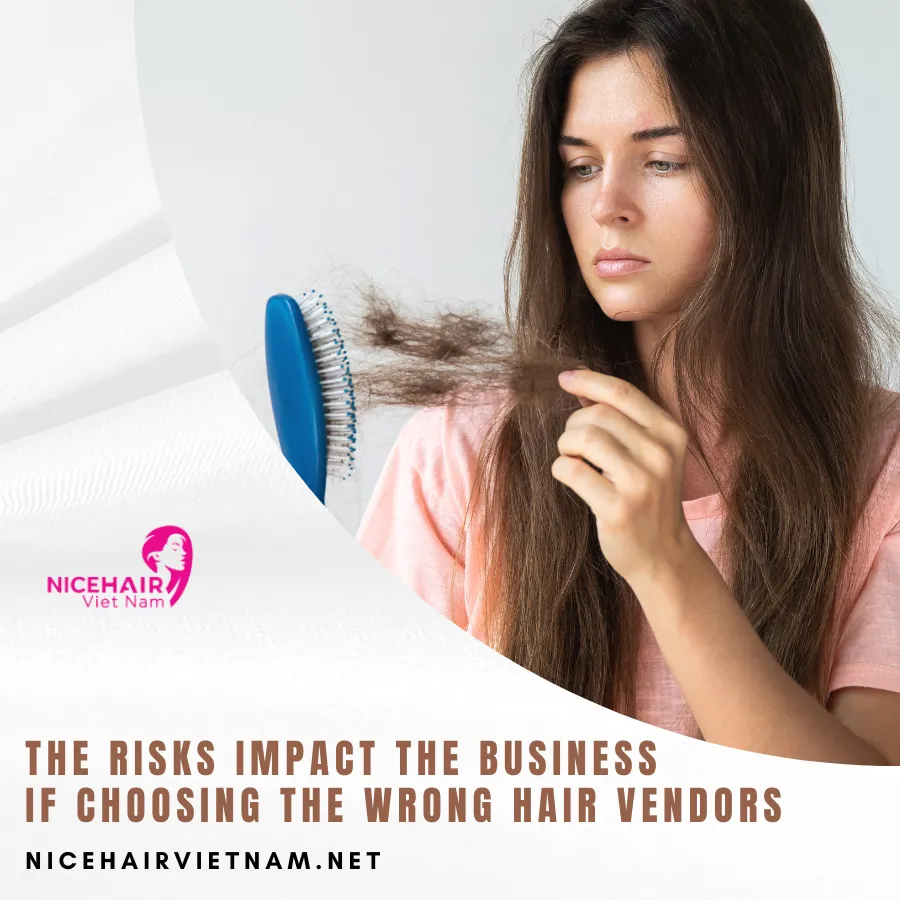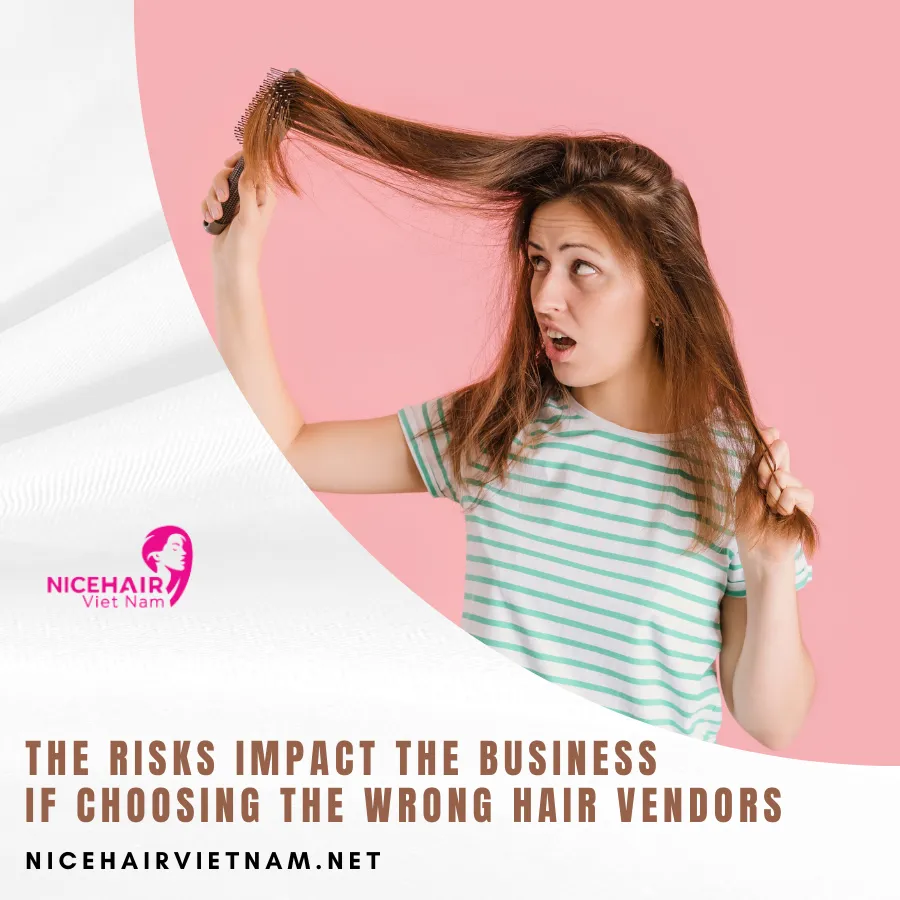As you’re likely aware, encountering a fraudulent hair vendors can lead to numerous challenges. Nice Hair Vietnam wishes to discuss two specific issues that individuals may encounter in such unfortunate situations.

Financial risks
Encountering a scam company poses substantial financial risks, and the unfortunate experiences shared by numerous clients underscore the severity of these challenges. Two prevalent scenarios highlight the gravity of the risks involved:
Complete Financial Loss
The ramifications of falling prey to a scam company extend far beyond a mere financial setback, with the complete loss of invested funds constituting one of the most distressing consequences. The tactics employed by scammers are often deceitful and manipulative, designed to convince unsuspecting individuals to execute financial transfers under false pretenses. Once the transfer is made, the scam company swiftly severs all communication and enacts a blockade, rendering any attempt at further contact futile.
The gravity of this situation manifests in the dire circumstances faced by victims, who find themselves in an abyss of financial loss with no recourse for restitution. The insidious nature of these scams lies in their meticulous planning and execution, leaving individuals not only without their hard-earned money but also without any viable means of reclaiming it. The lack of traceable details about the fraudulent entity further complicates the already challenging task of seeking financial justice.
The journey towards recovering from a complete financial loss due to a scam is fraught with obstacles. Victims often grapple with a sense of betrayal, as their trust has been exploited for illicit gains. The emotional toll, coupled with the harsh financial reality, underscores the need for heightened awareness and preventive measures in dealing with online transactions and unfamiliar entities.
Addressing this distressing scenario requires a multi-faceted approach. First and foremost, individuals must report the scam to relevant authorities and law enforcement agencies to contribute to the collective efforts in combating fraudulent activities. Simultaneously, raising awareness about the tactics employed by scammers can help prevent others from falling victim to similar schemes.

Financial institutions and regulatory bodies also play a crucial role in mitigating the impact of such scams. Enhanced security measures, stringent verification processes, and swift response mechanisms can act as deterrents and provide a layer of protection for consumers.
What is Financial institution?
A financial institution is an establishment that provides various financial services to its customers, including individuals, businesses, and governments. These institutions play a crucial role in the economy by facilitating the flow of money and capital. Financial institutions can be classified into different categories based on the range of services they offer and their specific functions. Here are some common types of financial institutions:
- Banks: Banks are perhaps the most well-known type of financial institution. They accept deposits from customers, provide loans, offer various types of accounts (such as savings and checking accounts), and facilitate electronic funds transfers.
- Credit Unions: Similar to banks, credit unions are financial institutions that provide banking services. However, credit unions are typically member-owned and operate as nonprofit organizations, often serving specific communities or groups of people.
- Investment Banks: These institutions specialize in facilitating the creation and sale of securities, such as stocks and bonds. They also provide advisory services for mergers and acquisitions, underwriting of new securities issuances, and other investment-related activities.
- Insurance Companies: Insurance companies provide various types of insurance coverage, including life, health, property, and casualty insurance. They collect premiums from policyholders and pay out claims when the insured event occurs.
- Central Banks: Central banks, such as the Federal Reserve in the United States or the European Central Bank, are responsible for monetary policy, controlling the money supply, and maintaining financial stability in a country or a group of countries.
Financial institutions are essential for the functioning of modern economies, as they provide the necessary infrastructure for saving, borrowing, investing, and managing risk in the financial system.
Furthermore, fostering a culture of digital literacy and educating individuals on recognizing potential scams is pivotal. Empowering consumers with knowledge about common red flags, verifying the legitimacy of companies, and exercising caution during online transactions can contribute to a more vigilant and resilient community.
In conclusion, the complete financial loss resulting from a scam company transcends mere monetary implications, leaving victims in a state of vulnerability and helplessness. Combating these threats requires a collaborative effort involving individuals, authorities, and institutions to create a more secure and informed digital landscape. Through collective awareness and proactive measures, it is possible to diminish the impact of such scams and empower individuals to navigate the online realm with greater confidence and resilience.
Receiving Incorrect or Substandard Products

Dealing with scam companies extends beyond financial loss, and another troubling dimension surfaces when victims receive products that significantly deviate from the promised quality or specifications. Despite the completion of the transaction and the dispatch of products, the items often fall far short of the standards advertised by deceitful vendors. This creates a complex predicament for victims, as not only have they lost money, but the received products are also rendered unsuitable for resale or any legitimate business activities.
The stark divergence between the promised and actual products introduces a profound challenge to victims’ ability to conduct honest and legitimate business. The products received, which may be substandard, defective, or entirely different from what was expected, lack the necessary market viability. This not only compromises the victim’s reputation but also obstructs their ability to make a fair return on investment or generate revenue from the sales of these misrepresented items.
Attempting to sell products that do not meet the promised specifications becomes a futile endeavor, exacerbating the already severe financial repercussions of engaging with a scam company. Customers who were expecting quality goods based on the vendor’s representations may express dissatisfaction, leading to potential disputes and tarnishing the victim’s credibility. This can have a lasting impact on their ability to attract and retain customers, further perpetuating the negative consequences of the fraudulent transaction.
In addition to the direct financial implications, victims must grapple with the ethical and reputational fallout. Trust, once eroded, is challenging to rebuild, and customers who feel deceived by receiving substandard products may be hesitant to engage with the victim’s business in the future. The victim is left not only with financial losses but also with the arduous task of restoring their reputation in the marketplace.
Addressing this perilous scenario necessitates a multifaceted approach. Victims should document and report the deceptive practices to relevant authorities and consumer protection agencies. Simultaneously, efforts to communicate openly with affected customers, offering refunds or replacements where possible, can help mitigate the reputational damage.
To prevent such occurrences in the future, businesses should implement rigorous supplier vetting processes, including thorough product inspections and quality control measures. Strengthening consumer education about recognizing trustworthy vendors and red flags associated with scam companies is crucial in building a more resilient and informed consumer base.
In conclusion, receiving incorrect or substandard products from scam companies goes beyond immediate financial consequences, impacting victims’ ability to conduct legitimate business and tarnishing their reputation. Vigilance, transparency, and proactive measures are essential for navigating this complex landscape and mitigating the long-term repercussions of engaging with deceitful vendors.
Quality Risk

The landscape of product quality in the hair industry is a multifaceted challenge, even when dealing with vendors who initially appear reputable. Beyond the surface of seemingly flawless products, a spectrum of quality issues can emerge, significantly impacting the effectiveness of marketing and selling these items. This underscores the critical importance of thorough vetting and due diligence when establishing partnerships within the complex hair supply chain.
- Mixed synthetic hair
One of the most disconcerting quality issues is the discovery of hair, purported to be natural, that is, in fact, blended with synthetic fibers. This misrepresentation not only compromises the integrity of product offerings but also has the potential to lead to customer dissatisfaction. Presenting hair as 100% natural while containing synthetic elements erodes the trust customers place in the brand and undermines the credibility painstakingly built over time. Addressing such quality discrepancies demands transparency with customers and, in certain instances, may require renegotiating terms with vendors to rectify the situation and regain consumer trust.
- Tangle and hair loss
Another prevalent quality concern surfaces when customers receive hair products prone to tangling and hair loss. Beyond reflecting poorly on the product itself, these issues jeopardize customer satisfaction, putting brand reputation and customer loyalty at risk. Tangling and shedding hair contribute to a negative customer experience, necessitating open communication with vendors to find effective solutions. This could involve product replacements, reevaluating partnership terms, or implementing measures to ensure the consistent delivery of high-quality, tangle-free products.
- Limited usage lifespan
The discovery that hair products have a limited effective usage lifespan, typically lasting only one to two months, presents a significant challenge. This limitation not only restricts the resale value of products but may also prompt customer complaints if the lifespan falls short of expectations. Establishing sustainable, long-term customer satisfaction requires engagement with vendors committed to providing products with extended durability. This not only enhances the resale potential of the products but also contributes to positive customer experiences and loyalty.
Successfully navigating these quality risks necessitates a comprehensive approach. Meticulous vendor selection, rigorous product testing, and proactive communication with customers are essential components. Clear expectations must be established with suppliers, and an ongoing dialogue about quality standards should be maintained to ensure consistency. In an industry where the tangible nature of the product is crucial, prioritizing robust quality control measures is paramount for sustained success, positive customer relations, and the overall health of the business.

